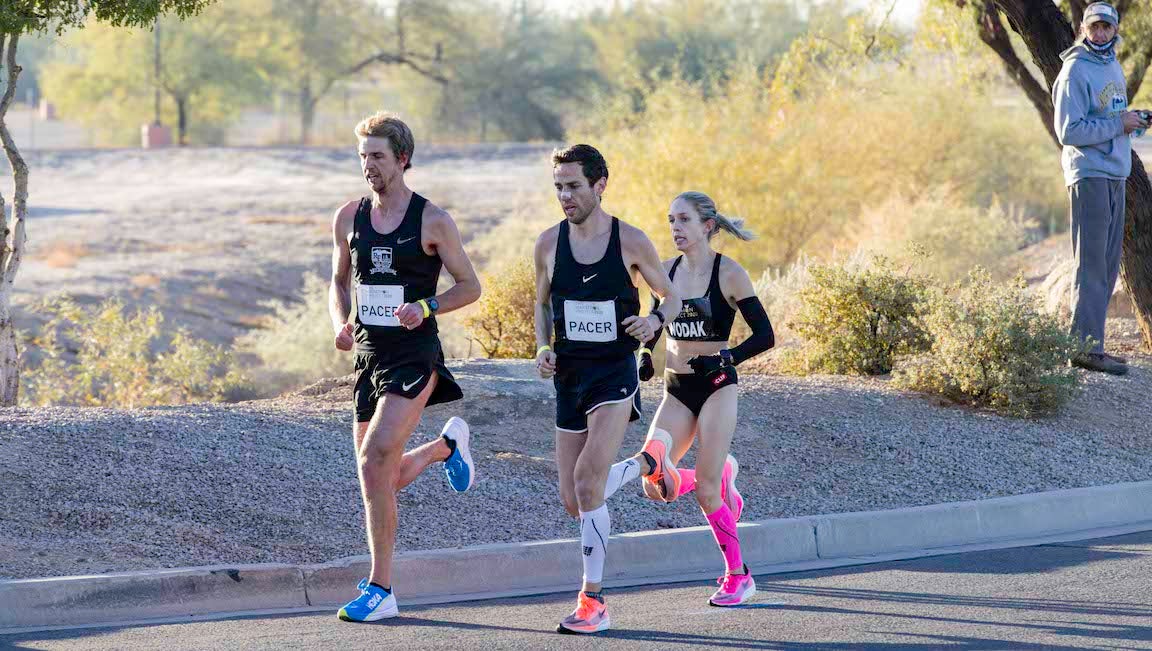The Importance of Running Your Own Race, and a Case Study on How To Do It

(Photo: Luke Webster)
The week before Christmas, Natasha Wodak returned in style to the marathon. After a 7-year hiatus, the 10,000m Canadian record holder returned to the 26.2-mile race finishing with a 10-minute PR, easily securing the Olympic Standard time. With a goal of 2:26 at the Marathon Project, she delivered as promised, running perfectly consistent 5:35 mile splits to finish 4th, her 2:26:19 making her the 2nd fastest woman in Canada’s history.
Wodak’s return to the marathon occurred at the Marathon Project on Sunday, Dec. 20. The race—held on a nearly flat course in Chandler, Arizona, designed specifically for fast marathon times—was one of the few opportunities in 2020 for elite athletes to race fast times. At the age of 39, Wodak knew that returning to the marathon distance was a challenging and potentially risky endeavor. Yet, entering the race she was ready to go. The combination of her training, coaching, mental game, and strategy poised her to run a phenomenal race. Without a doubt, Wodak arrived in Arizona with a plan to run her own race, and she did exactly that. Here are a few of the strategies she used to meet her goal.
RELATED: Sara Hall is Now the Second-Fastest American Marathoner in History

Have a Coach
Beginning her training block for the marathon, Wodak knew that she would have to do things differently from past training regiments. Acknowledging her history of injuries and burnout, it was imperative to change the way she thought about training; her new motto leading up to the Marathon Project was: Run Free, Run Happy. For Wodak, the shift occurred in large part because of her coach, Lynn Kanuka. Working together they created a plan that would “make me happy and in a way that I would enjoy the process.” While having a coach isn’t a necessity to running a fast marathon, it is deeply beneficial for Wodak, giving her the freedom to think less about her training plan and to focus more on executing the plan well.
There will always be doubts leading into a race, so it is even more important to believe in the work you are doing. “You have to be confident and self-assured that what you’re doing is working” says Wodak. Having a coach and a plan she trusted enabled her to focus on training instead of stressing about the plan: “If you’re stressing about your training it’s probably taking valuable energy away from your training.”
Have a Race Strategy

Toeing the starting line Wodak had a strategy in place: run 26 even 5:35 miles. While a lot can go wrong in a race to disrupt a plan, it’s vital to know what pace you can set and to attempt to execute it. Working with the 2:26 pace group she described the pacers as “metronomes,” clocking near-perfect 5:35 miles. While the pacers didn’t make the miles any easier, they helped Wodak and her coach execute their plan.
Own Your Plan
“We all know there are many different paths to the same destination,” said Wodak describing her training for the Marathon Project. For every runner the journey to the starting line is different; each athlete must build off of different strengths and weaknesses. While it is easy to try and conform your training to others, it’s essential to remember that every athlete is different.
For Wodak, she understood that her approach to training for her second marathon would be different from other top runners. One big change was her cross-training. “We did a lot of cross-training, especially on the elliptical. Instead of running twice a day I would cross-train in the afternoon.” While training for a marathon on an elliptical is not the most conventional method, Wodak knew that she had to tailor her training to her own body, working her engine while lessening the stress on her legs.

Have a Checklist
“They say it’s easy until it’s not; it got hard quick,” said Wodak in a post-race interview. Regardless of the pace, marathons are hard. At times every mile requires mental strength to push through the pain. For Wodak she found reprieve from the suffering in the form of a mental checklist. Working through the list in her mind, she was able to distract herself and simultaneously refocus her mind on the things that matter.
Wodak’s checklist included: “How am I breathing; where are my arms (bring them in); count each step, one-two-one-two; repeat my affirmation phrases; think about my form.” When the going gets hard, this checklist is seared into Wodak’s mind from her countless hours of training, helping her focus on the important things instead of the pain.
Have Perspective

Regardless of who you are, running a marathon PR is an accomplishment to be proud of. It is a beautiful and satisfying reward for months and years of training. Yet, after decades of racing, Wodak believes that a PR cannot be the only metric to a good race. When describing her training she says, “Of course there is a large amount of grinding, but I have one life to live and I need to enjoy it.” At the end of the day, we all want to race well, but often, to race well means giving ourselves space and perspective to rest, recover, and enjoy life.